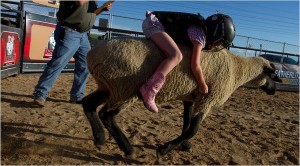In addition to reading a lot of books, I read a lot of magazines. Sometimes it takes me awhile to get through the stack on my nightstand, but I always do. I recently read two articles in my "regulars" (New Yorker and Sports Illustrated) that spoke to one another in important ways-- even if no one else sees it but me! The first is "The Ride of Their Lives: Children prepare for the world's most dangerous organized sport" by Burkhard Bilger in last month's New Yorker and the second is "Out of Power" by Pete Thamel in the August 25th issue of SI about Curtis Malone, a convicted drug dealer who ran one of the most influential AAU basketball programs in the country. I've written a bit about mutton busting before, and the circuit has only intensified since I last wrote (kids with stage names, customized clothes, bling, etc.). Here are the ways in which these article reveal these two very different youth sports are similar to one another, and the constellation of other competitive youth activities. These are both worlds where kids get nicknames (see also the recent NYT piece on girls in a boys' basketball league, which is full of stereotypes), can earn gear and swag, and potential earn money (a lot of it in fact).
The line that resonated most with my Playing to Win research, and my beauty pageant research, from the Bilger article is, "Around here, the notion of childhood as a safe, protected place—a benign bubble—seemed like poor training for life." Bilger is a gorgeous writer-- his prose is evocative, the details truly evocative and illustrative. But this sentence captures the hardscrabble hopes so many parents have for their children, and the ways in which activities outside of school can lead to other opportunities. IN both Oklahoma and Texas and DC, basketball and rodeo offer real benefits, despite the risks (whether they be injuries or drugs).
In both activities the authors discuss the intensification over the past decades-- more people, more money, more business opportunities. As the stakes get higher in childhood in general, we see what I refer to as cottage industries spring up that enable adults, who may be helping children at first (and some continue to, but not all), make more and more money. As Thamel writes, "Malone quickly grasped that in the essentially unregulated youth basketball world, the key is to acquire talent." Thamel finds that the same skills that make someone successful as a drug dealer work when it comes to youth basketball: charisma, street savvy, discretion, and organization. I can assure you that this is also true when it comes to kids' chess, dance, soccer, beauty pageants, afterschool math classes, etc. So long as the realms remain unregulated, this will remain true.
One of my favorite lines from the Bilger piece was a line uttered by a parent about his son trying to stay on a calf for 8 seconds. His son fell off but the dad remarked, "He hit the ground trying." This is both a great lesson kids can gain from participating in activities like these, but it also suggests the potential pitfalls for so many adults, including parents, involved. If the focus stays more on the kids' learning, and less on profit, hopefully this can be true for all kids...

